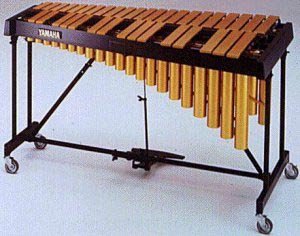
Name of instrument:
Xylophone
Origins:
The xylophone is believed to have originated in southeastern Asia. Models were later developed in western and eastern Africa. It is likely that the xylophone reached Europe during the Crusades and the earliest historical reference in Europe is in 16th Century Germany in organist Arnold Schlick's Spiegel der Orgelmacher und Organisten.
Parts:
The modern western-style xylophone has bars made of rosewood or more commonly, kelon, an extremely durable fiberglass that allows a louder sound at the expense of tone quality. Some xylophones can be as small as 2 1/2 octaves but concert xylophones are typically 3 1/2 or 4 octaves.
Concert xylophones have resonators below the bars to enhance the tone and sustain. Frames are made of wood or cheap steel tubing; more expensive xylophones feature height adjustment and more stability in the stand.
In other music cultures, xylophones have wooden bars and a wooden frame. Some versions have resonators made of gourds.
Usage:
Xylophones are tuned to different scale systems depending on their origin, including pentatonic, heptatonic, diatonic, or chromatic. The arrangement of the bars is generally from low (longer bars) to high (shorter bars). The musician will struck the bars with plastic, wooden, or rubber mallets.
With the xylophone, we can play melodies and it is easy to learn and easy to play.
photo taken from http://musicalinstrumentsonsale.com/xylophones/xylophones.htm